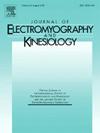Comparing motor unit number estimation techniques
IF 2.3
4区 医学
Q3 NEUROSCIENCES
引用次数: 0
Abstract
It is unclear how comparable motor unit number estimates (MUNEs) are when derived from a non-invasive technique involving repetitive peripheral nerve stimulation vs. one involving volitional contractions and intramuscular recordings of single motor units (MUs). Therefore, this study examined MUNEs from MScanFit (MScan) and Decomposition-Enhanced Spike-Triggered Averaging (DE-STA). Eighteen participants (8 females, 10 males; 29.7 ± 7.1 years) sat with their right leg positioned in an isometric myograph while surface electromyography (EMG) was recorded from the tibialis anterior (TA). The MScan protocol isolated and derived the size of single MUs by repeatedly stimulating the common fibular nerve at progressively weaker currents to model a compound muscle action potential (CMAP) stimulus–response curve. For DE-STA, a concentric needle electrode was inserted into the TA, and participants performed 30-s isometric dorsiflexion contractions at 25 % of maximal voluntary torque to obtain ≥20 individual surface MU potentials (S-MUPs; i.e., single MUs extracted from the surface EMG signal based on needle-detected spikes). Both techniques used the same maximal CMAP to calculate a MUNE, yet MScan used a mathematical model to simulate the recorded CMAP stimulus–response, which was compared to the recorded scan to minimize disagreement; whereas DE-STA compared the size of the maximal CMAP to the average S-MUP. There was no difference between the MUNE calculated via DE-STA (132 ± 26 MUs) and MScan (142 ± 22 MUs; p = 0.11), and the bias (10.0 MUs) and limits of agreement (67.6 vs −47.6 MU difference) suggests that either technique may independently offer a reasonable MU estimate for the TA of young adults.
比较运动单元数估计技术
目前尚不清楚,重复性周围神经刺激的非侵入性技术与意志收缩和单个运动单位(MUs)的肌肉内记录的技术相比,可比性运动单位数估计(MUNEs)的效果如何。因此,本研究检查了MScanFit (MScan)和分解增强峰值触发平均(DE-STA)的MUNEs。18名参与者(女性8人,男性10人;29.7±7.1岁)坐下,右腿定位于等长肌图,记录胫骨前肌(TA)的肌表电图(EMG)。MScan方案通过以逐渐变弱的电流反复刺激腓骨总神经来模拟复合肌肉动作电位(CMAP)刺激-反应曲线,从而分离并推导出单个MUs的大小。对于DE-STA,将一个同心针电极插入TA,参与者以最大自主扭矩的25%进行30秒的等长背屈收缩,以获得≥20个个体表面MU电位(S-MUPs);即,根据针检测到的尖峰从表面肌电信号中提取单个mu)。两种技术都使用相同的最大CMAP来计算MUNE,但MScan使用数学模型来模拟记录的CMAP刺激反应,并将其与记录的扫描进行比较,以尽量减少差异;而DE-STA将最大CMAP的大小与平均S-MUP进行比较。通过DE-STA计算的MUNE(132±26 MUs)与MScan计算的MUNE(142±22 MUs)无差异;p = 0.11),偏差(10.0 MU)和一致性限制(67.6 vs - 47.6 MU差异)表明,这两种技术都可以独立地为年轻人的TA提供合理的MU估计。
本文章由计算机程序翻译,如有差异,请以英文原文为准。
求助全文
约1分钟内获得全文
求助全文
来源期刊
CiteScore
4.70
自引率
8.00%
发文量
70
审稿时长
74 days
期刊介绍:
Journal of Electromyography & Kinesiology is the primary source for outstanding original articles on the study of human movement from muscle contraction via its motor units and sensory system to integrated motion through mechanical and electrical detection techniques.
As the official publication of the International Society of Electrophysiology and Kinesiology, the journal is dedicated to publishing the best work in all areas of electromyography and kinesiology, including: control of movement, muscle fatigue, muscle and nerve properties, joint biomechanics and electrical stimulation. Applications in rehabilitation, sports & exercise, motion analysis, ergonomics, alternative & complimentary medicine, measures of human performance and technical articles on electromyographic signal processing are welcome.

 求助内容:
求助内容: 应助结果提醒方式:
应助结果提醒方式:


